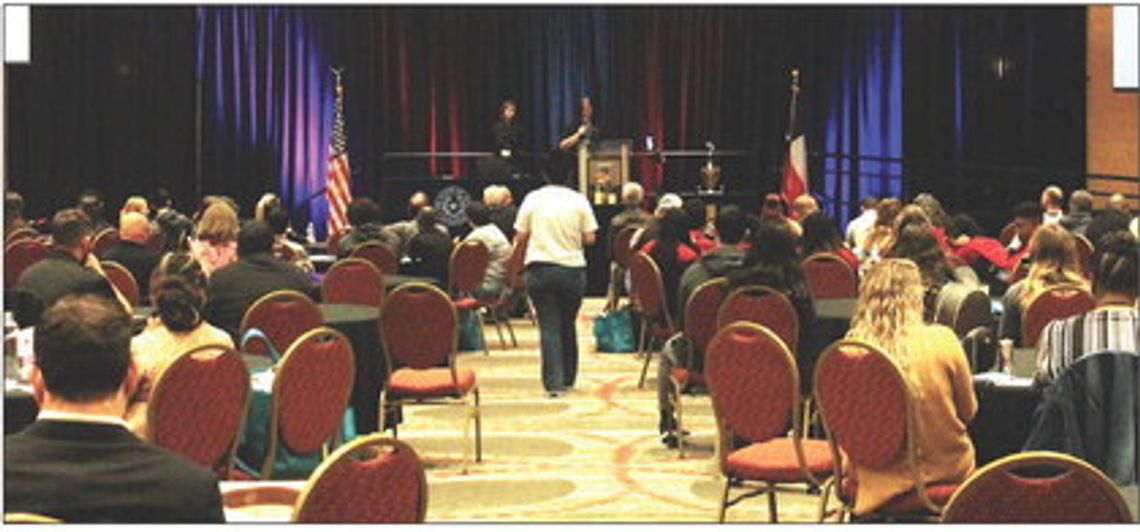Hays County — There's no better group to be the change that addresses and tackles the issues facing teens than teens themselves.
Hays County Crime Stoppers hosted its 27th Annual Texas Crime Stoppers Campus Conference called “Clued In,” which was held across two full days at the Embassy Suites Hotel Convention Center in San Marcos. Hundreds of high school students from around Texas attended to meet other students and discuss issues like school safety, domestic and dating violence, sex trafficking, cyberbullying, suicide prevention and a roundtable on police-community perceptions.
Prior to the official start of the conference on Monday morning, a special teen-led panel on fentanyl was added to the lineup. For the past several months, the Hays County community has grappled with the fentanyl crisis — so far, fentanyl poisonings have led to the deaths of five Hays CISD students in less than a year.
The discussion was robust and at times, emotional, as young, bright minds shared their ideas and perspectives throughout the panel conversation.
Students Rachel Fernandez, Xochi Schon-Wright and Katalina Ornelas of Hays High School’s Campus Crime Stoppers group led the panel. Hays County Communications Manager, HCCS volunteer and conference chair Kim Hilsenbeck served as moderator. Students in the audience were also given the chance to participate in the discussion.
“What we’re looking for today are solutions,” Hilsenbeck said. “We are looking for a, ‘How do we address some of these things before we get to an opioid overdose?’ … I need you to know that we, as adults, are here to listen to you. I don’t think we do enough of that.”
The panelists spoke about how many teens face mental health struggles that they don’t want to talk about and that others might find difficult to understand. This feeling of isolation, mixed with the easy accessibility of finding drugs on social media apps like Snapchat, have created the dire situation seen today.
“I feel like a lot of the kids don’t feel heard,” Fernandez said. “They are going through pain that a lot of us will never understand, or that we can only do so much to help.”
Starting the dialogue to help combat this can be difficult, but most of the time, all it takes is lending an ear.
“I would listen to what they’re going through and what they want to say,” Ornelas said. “They can die. Express that people would miss them. I would miss them. They have so many other opportunities and potential that they don’t want to miss out on.”
One of the key takeaways from the discussion was the importance of students being able to find a safe, non-judgmental and stable environment to discuss their drug use or other problems, either with peers or a trusted adult, to negate the fear of getting in trouble with family members, school faculty or law enforcement.
Students also spoke about being more kind and understanding to peers, but also being honest and straightforward in helping them find better coping mechanisms.
“Another problem in this day and age is, if you’re going to be there for someone, then you should stick it out to the end,” said Julissa, a member of Hays HS Campus Crime Stoppers. “Because it sucks whenever you say you’re going to be there for them, and then you’re not there when they actually need you. That hurts the most and makes it 10 times worse.”
“There’s power in partnership,” added student Morgan.
Students also agreed that comprehensive and meaningful drug education — even showing the “dirty” side of drugs, said Schon-Wright — needs to start at the elementary school level so it is ingrained in them. Accidental overdoses and even just the first-time curious users are also very much so [a] part of the conversation.
“I think it’s a little bit privileged of us as a society to say that anyone wants to do drugs. I feel like there’s a large stigma around everyone that does drugs, and the assumption that they’re bad people,” said Hannah, a Johnson High School student. “A lot of opioid overdoses and addictions can come from hospitals, from injuries that you’re trying to recover from. So I think to say that anyone wants to do drugs is in some ways incorrect. You can sometimes just fall into it. There’s no yes or no, right or wrong to it. I think that part of the problem is that we have to change the stigma. We can’t keep saying [that] the people who do drugs are bad people, and that they choose this path and this lifestyle. Because they don’t always. It’s not that they want to do drugs, it’s that they want to escape the situation that they’re in.”
The opening ceremony followed the panel discussion and included the annual lighting of the victims' candles. At each conference, candles are lit to honor the memory of all victims of crime, including citizens and law enforcement. This year, another candle was carried and lit by Janel Rodriguez in memory of her 15-year-old son Noah who died from fentanyl poisoning in August 2022.
“One bad decision ended everything he had going for him,” Rodriguez said. “I tell you today: if you know something, if you see something, say something. If my son had somebody in his group of friends say something to someone, he could still be here today.”
Fighting fentanyl crisis from teens’ perspectives
— There's no better group to be the change that addresses and tackles the issues facing teens than teens themselves.
- 02/08/2023 12:00 AM











